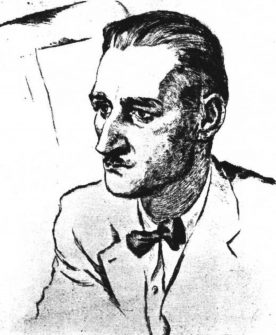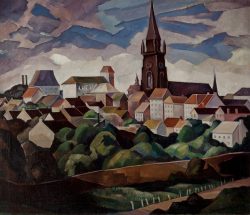Emile Jacques Grumieaux, from a drypoint etching by Frances Foy published in unidentified source, in Grumieaux file, Chicago Artists’ Archive, Chicago Public Library Harold Washington Library Center.

Emile Grumieaux 1897–1954
Born in Gosselies, Belgium, Emile Jacques Grumieaux was brought to the U.S. as a small child. His father, Louis P. Grumieaux, was a painter. The younger Grumieaux attended the Art Institute of Chicago and the Chicago Academy of Fine Arts (founded in 1902) and then returned to his native land for further study. Working in both oils and watercolor, Grumieaux specialized in landscapes painted throughout the Midwest as well as in Belgium, France, England, and Canada, and he also painted still lifes. He began exhibiting actively in 1924, when he first contributed paintings to the “Chicago and Vicinity” annual exhibitions at the Art Institute and to the alternative shows organized by the Chicago No-Jury Society of Artists. He was also active in the Chicago Society of Artists, of which he served as president from 1927 to 1930, and the Illinois Academy of Fine Arts, winning prizes at each in 1927 and 1928 respectively. He was a member of The Ten, a group of Chicago modernist painters who showed in their own twice-yearly exhibitions at the Marshall Field and Company department store gallery beginning in 1930.
A mainstay of Chicago’s progressive artists’ community, Grumieaux was featured in J. Z. Jacobson’s Art of Today: Chicago, 1933, in which he wrote in his artist’s statement that “Every completed picture marks a step forward in the elimination of unessential detail.”i His particular brand of modernism united a bold simplification of form with largely traditional subject matter that had broad appeal. On the occasion of his first solo exhibition, at the Chicago Woman’s Aid club in 1928, critic Marguerite Williams remarked approvingly that Grumieaux’s “claims to the modern school lie in his search for form and abstract design[,] not in any desperate straining to be ‘wild’ and different.”ii
In addition to painting, Grumieaux taught at Chicago’s National Academy of Art and in the late 1930s he was employed in the easel division of the WPA’s Illinois Art Project. By 1940 he was working as an art director at Goldblatt’s Department Store and in the 1950s he was employed as a commercial artist at Hoskinson and Rohloff Studios in Chicago. In the 1920s Grumieaux lived in suburban Palos Park, Illinois, where his father also resided, but around 1929 he settled permanently in Downers Grove, Illinois, where he served as vice-president of the Downers Grove Art Guild.
Wendy Greenhouse, PhD
i J. Z. Jacobson, Art of Today: Chicago, 1933 (Chicago: L. M. Stein, 1932), 72.
ii Marguerite Williams, “Here and There in the Art World,” Chicago News, Oct. 17, 1928.
